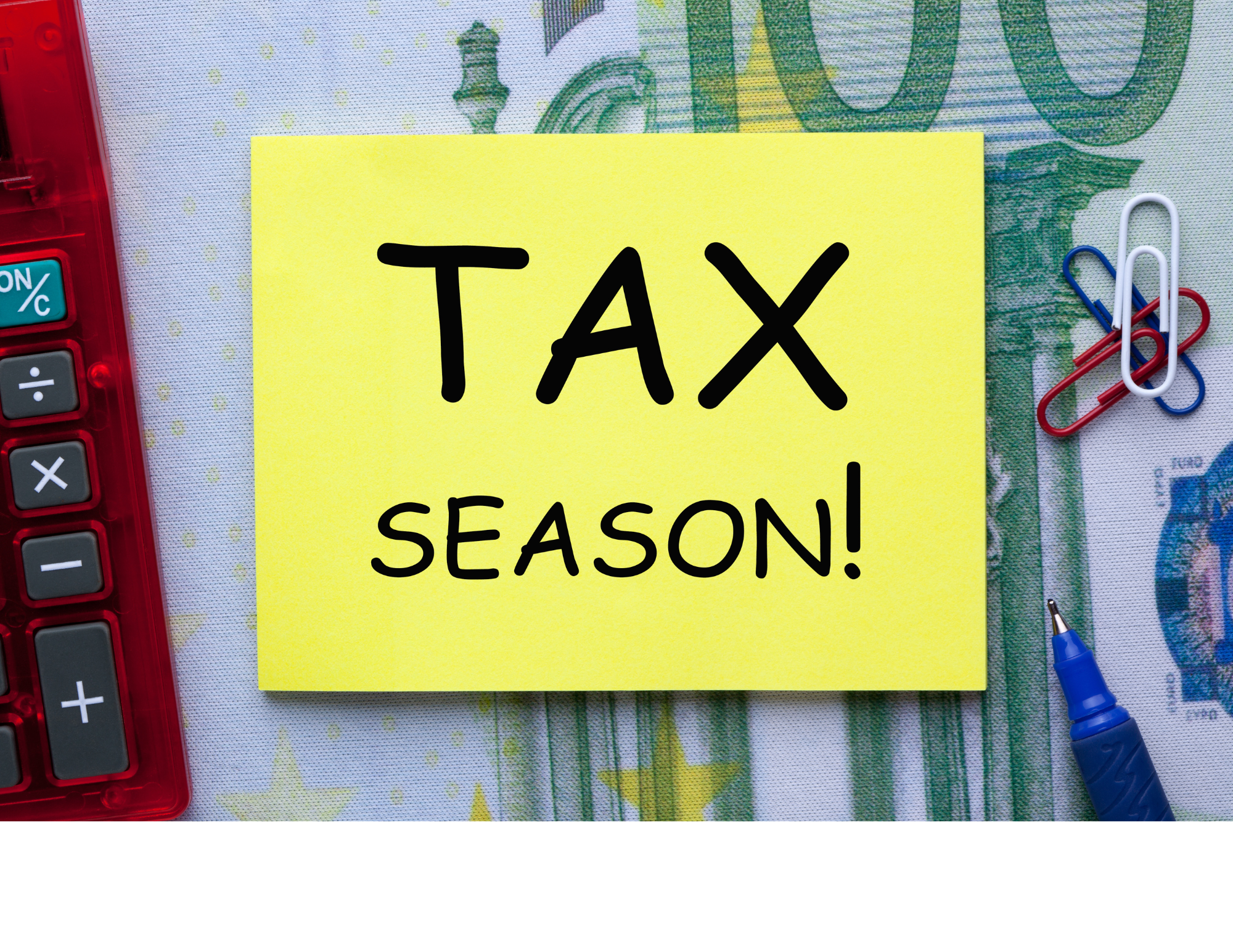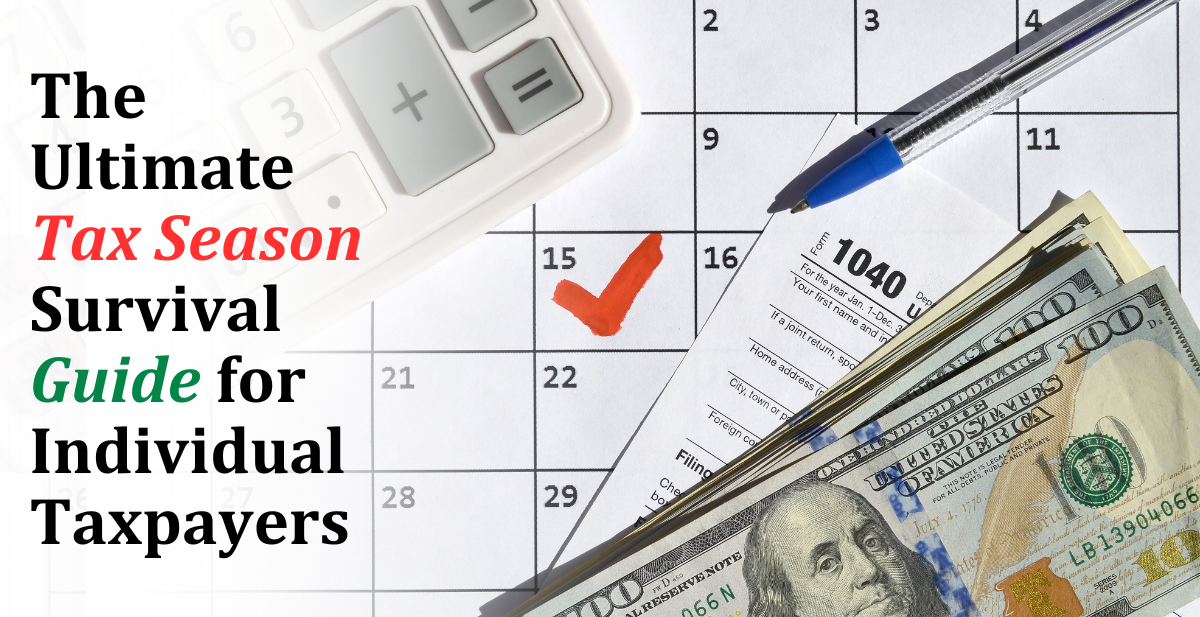Navigating Tax Season 2025: The Ultimate Tax Season Survival Guide for Individual Taxpayers
As we approach the 2025 tax season, many individual taxpayers find themselves grappling with the complexities of the U.S. tax system. This comprehensive guide aims to demystify the process, providing you with the knowledge and tools necessary to navigate tax season confidently and efficiently.
Understanding Tax Season Basics

What is Tax Season?
Tax season is the period each year when individuals and businesses prepare and file their tax returns for the previous year’s income. In the United States, this typically runs from January 1st to April 15th, though the exact dates can vary slightly from year to year.
For individual taxpayers, tax season is a crucial time to review your financial situation, gather necessary documents, and fulfill your legal obligation to report income and pay taxes to the government. It’s also an opportunity to claim deductions and credits that can reduce your tax liability or increase your refund.
Key Dates and Deadlines for 2025
As we look ahead to the 2025 tax season, it’s essential to mark these important dates on your calendar:
- January 1, 2025: The official start of tax season. The IRS typically begins accepting tax returns on this date.
- April 15, 2025: The standard deadline for filing individual tax returns for the 2024 tax year.
- October 15, 2025: The extended deadline for those who file for an extension.
Additionally, if you’re required to make estimated tax payments, keep these quarterly due dates in mind:
- April 15, 2025 (for January 1 to March 31)
- June 15, 2025 (for April 1 to May 31)
- September 15, 2025 (for June 1 to August 31)
- January 15, 2026 (for September 1 to December 31)
Pro Tip: Mark these dates in your digital calendar with reminders set a few weeks in advance to ensure you’re prepared.
Who Needs to File Taxes?
Not everyone is required to file a federal tax return. The requirement to file depends on several factors, including your income, filing status, and age. For the 2024 tax year (filed in 2025), here are the general income thresholds:
| Filing Status | Age | Minimum Income Requirement |
|---|---|---|
| Single | Under 65 | $12,950 |
| Single | 65 or older | $14,700 |
| Married Filing Jointly | Both under 65 | $25,900 |
| Married Filing Jointly | One spouse 65 or older | $27,300 |
| Married Filing Jointly | Both 65 or older | $28,700 |
| Head of Household | Under 65 | $19,400 |
| Head of Household | 65 or older | $21,150 |
Note: These figures are based on the 2022 tax year and may be adjusted for inflation for the 2024 tax year. Always check the official IRS website for the most up-to-date information.
Even if you fall below these thresholds, you may still want to file a return if:
- You had federal income tax withheld from your pay
- You made estimated tax payments
- You qualify for refundable credits like the Earned Income Tax Credit
Special circumstances that may require you to file regardless of income include:
- Self-employment income of $400 or more
- Owing special taxes (like alternative minimum tax or household employment taxes)
- Receiving distributions from a health savings account (HSA)
Understanding these basics is the first step in successfully navigating tax season. In the following sections, we’ll delve deeper into the preparation process, filing methods, and strategies to maximize your return while minimizing stress.
Preparing for Tax Season: A Step-by-Step Approach

Gathering Necessary Documents
Proper preparation is key to a smooth tax filing experience. As we approach the 2025 tax season, it’s crucial to start gathering all necessary documents well in advance. Here’s a comprehensive list of what you might need:
- Income Documents:
- W-2 forms from all employers
- 1099 forms (various types):
- 1099-MISC for independent contractor work
- 1099-INT for interest income
- 1099-DIV for dividend income
- 1099-G for unemployment benefits or state tax refunds
- 1099-R for distributions from retirement accounts
- K-1 forms for income from partnerships, S corporations, or trusts
- Social Security benefits statement (Form SSA-1099)
- Deduction and Credit Documents:
- Mortgage interest statement (Form 1098)
- Property tax receipts
- Charitable donation receipts
- Medical expense records
- Educational expense records (Form 1098-T for tuition, receipts for books and supplies)
- Child care expense records
- Receipts for energy-efficient home improvements
- Investment and Savings Information:
- Year-end account statements for investment accounts
- Records of contributions to IRAs or other retirement accounts
- Records of Health Savings Account (HSA) contributions and distributions
- Business Records (if self-employed):
- Income records
- Expense receipts
- Vehicle mileage logs
- Home office measurements and expenses
- Personal Information:
- Social Security numbers for yourself, spouse, and dependents
- Bank account and routing numbers for direct deposit of refund
Pro Tip: Create a dedicated “Tax Documents” folder, either physical or digital, at the beginning of each year. Throughout the year, place relevant documents in this folder as you receive them.
Organizing Financial Records
Once you’ve gathered your documents, the next step is to organize them effectively. Here are some strategies:
- Digital Organization:
- Use cloud storage services like Google Drive or Dropbox to create a tax document folder.
- Scan paper documents and save them as PDFs with clear, descriptive file names.
- Use financial software like Quicken or Mint to categorize and track expenses throughout the year.
- Physical Organization:
- Use a multi-pocket folder or accordion file to separate documents by category.
- Label each section clearly: Income, Deductions, Investments, etc.
- Keep a running list of documents you’re expecting and check them off as they arrive.
- Create a Tax Preparation Checklist:
- List all the forms and documents you typically need.
- Include deadlines for gathering each item.
- Note any new tax situations that may require additional documentation.
Case Study: Sarah, a freelance graphic designer, struggled with tax preparation until she implemented a robust organization system. She now uses a combination of digital and physical methods:
- She scans all receipts immediately using her smartphone and saves them to a cloud-based folder.
- She uses accounting software to track income and expenses, categorizing them as she goes.
- She maintains a physical folder for hard copies of important documents like 1099 forms.
- At the end of each quarter, she reviews her digital and physical records to ensure everything is in order.
This system has saved Sarah hours of stress during tax season and has helped her maximize her deductions.
Understanding Your Tax Situation
Before diving into the filing process, it’s crucial to assess your current tax situation:
- Determine Your Filing Status:
- Single
- Married Filing Jointly
- Married Filing Separately
- Head of Household
- Qualifying Widow(er)
Your filing status can significantly impact your tax liability and available deductions and credits. For detailed information on determining your filing status, visit the IRS website’s Filing Status page.
- Identify Life Changes That May Affect Your Taxes:
- Marriage or divorce
- Birth or adoption of a child
- Purchase or sale of a home
- Starting or closing a business
- Retirement
- Assess Your Income Sources:
- Wages and salaries
- Self-employment income
- Investment income (dividends, capital gains)
- Rental income
- Retirement distributions
- Unemployment benefits
- Review Potential Deductions and Credits:
- Standard deduction vs. itemized deductions
- Education credits (American Opportunity Credit, Lifetime Learning Credit)
- Child Tax Credit
- Earned Income Tax Credit
- Energy-efficient home improvement credits
- Consider Tax Law Changes: As we approach 2025, it’s crucial to stay informed about recent and upcoming tax law changes. For instance, the Tax Cuts and Jobs Act of 2017 is set to expire after 2025, which could significantly impact tax brackets, deductions, and credits. Keep an eye on IRS Tax Tips for the most up-to-date information.
By thoroughly understanding your tax situation, you can make informed decisions about which filing method to use and whether you might benefit from professional assistance.
Choosing the Right Method to File Your Taxes

DIY Tax Preparation
For many taxpayers, self-preparing and filing taxes can be a cost-effective and educational experience. Here’s what you need to know:
Pros of DIY Tax Preparation:
- Cost savings compared to hiring a professional
- Greater understanding of your financial situation
- Flexibility to work on your return at your own pace
Cons of DIY Tax Preparation:
- Time-consuming, especially for complex tax situations
- Risk of errors if you’re not familiar with tax laws
- Potential for missed deductions or credits
Popular Tax Software Options:
- TurboTax: Known for its user-friendly interface and step-by-step guidance.
- H&R Block: Offers both online and downloadable software with options for in-person support.
- TaxAct: A budget-friendly option with a accuracy guarantee.
- FreeTaxUSA: Free federal filing for all tax situations, with a low-cost state return option.
When choosing tax software, consider factors such as:
- Cost (including fees for state returns)
- User interface and ease of use
- Available support options (chat, phone, email)
- Audit support features
Tips for Successful DIY Filing:
- Start early to avoid last-minute rush and stress
- Gather all necessary documents before beginning
- Take advantage of knowledge bases and support options provided by the software
- Double-check all entries for accuracy
- Save a copy of your completed return for your records
Benefits of Using Tax Software
Tax preparation software has revolutionized the way individuals file their taxes. Here are some key benefits:
- Accuracy: Most tax software uses error-checking algorithms to catch common mistakes.
- Up-to-Date Information: Tax laws change frequently, and reputable software is updated to reflect the latest regulations.
- Guided Process: Many programs use an interview-style format to walk you through the filing process step-by-step.
- Time-Saving: Once you’ve entered your basic information, many details can be carried over from year to year, saving time on future returns.
- Maximizing Deductions and Credits: Good tax software will ask questions to help identify all potential deductions and credits you may be eligible for.
- Electronic Filing: Most software allows for easy e-filing, which is faster and more secure than mailing a paper return.
- Audit Support: Many tax software packages offer some level of audit support if your return is flagged by the IRS.
Comparison of Top Recommended Software (2025 Estimates):
| Software | Basic Price | Deluxe Price | Premium Price | State Return Fee |
|---|---|---|---|---|
| TurboTax | $0 | $59 | $89 | $49 |
| H&R Block | $0 | $49 | $79 | $39 |
| TaxAct | $0 | $39 | $69 | $39 |
| FreeTaxUSA | $0 | $0 | $6.99 | $14.99 |
Note: Prices are estimates based on previous years’ trends and may change. Always check the official websites for the most current pricing.
Working with a Tax Professional
While DIY options have become increasingly sophisticated, there are still many situations where working with a tax professional can be beneficial. Here’s what you need to know:
When to Consider Professional Help:
- Complex financial situations (multiple income sources, investments, rental properties)
- Major life changes (marriage, divorce, buying a home, starting a business)
- Self-employment or business ownership
- International tax issues
- Previous tax problems or concerns about an audit
- Lack of time or confidence in preparing your own return
Types of Tax Professionals:
- Certified Public Accountants (CPAs):
- Licensed professionals with extensive training in accounting and tax law
- Can represent you before the IRS in case of an audit
- Often specialize in complex tax situations
- Enrolled Agents (EAs):
- Licensed by the IRS to represent taxpayers
- Specialize in tax preparation and have unlimited practice rights
- Often more affordable than CPAs
- Tax Attorneys:
- Lawyers specializing in tax law
- Best for complex legal issues, tax disputes, or business structuring
- Generally the most expensive option
- Tax Preparers:
- Includes a wide range of professionals, from seasonal workers to year-round tax specialists
- Varying levels of expertise and credentials
How to Choose the Right Tax Professional:
- Check Credentials: Verify that the professional is licensed and in good standing. You can use the IRS Directory of Federal Tax Return Preparers to find credentialed preparers in your area.
- Consider Experience: Look for someone with experience in your specific tax situation (e.g., self-employment, international income).
- Ask About Fees: Understand their fee structure upfront. Some charge by the hour, others by the form, and some have a flat fee based on the complexity of your return.
- Inquire About Availability: Ensure they’ll be available for questions after tax season, especially if you’re audited.
- Check References: Ask for and contact references to gauge their experience with the preparer.
- Evaluate Communication Style: Choose someone who explains things in a way you understand and makes you feel comfortable.
Advantages of Hiring a Tax Professional:
- Expertise in complex tax laws and regulations
- Time-saving for the taxpayer
- Potential for identifying additional deductions and credits
- Year-round tax planning advice
- Representation in case of an audit
Case Study: John, a freelance consultant with income from multiple states and countries, tried to file his own taxes for years. He often felt uncertain about international tax laws and worried about potential mistakes. In 2024, he decided to hire a CPA specializing in international taxation. The result:
- His CPA identified several deductions he had been missing, resulting in a larger refund that more than covered the professional fees.
- John gained peace of mind knowing his complex tax situation was handled correctly.
- His CPA provided valuable advice on structuring his business to optimize his tax situation for future years.
Free Tax Preparation Services
For eligible taxpayers, there are several free tax preparation options available:
- IRS Free File Program:
- Available to taxpayers with adjusted gross income (AGI) of $73,000 or less (as of 2024, may be adjusted for 2025)
- Offers free federal tax return preparation and e-filing
- Some participating software providers also offer free state returns
- Learn more about IRS Free File
- Volunteer Income Tax Assistance (VITA):
- Free tax help for people who generally make $60,000 or less
- IRS-certified volunteers provide free basic income tax return preparation
- Includes free electronic filing
- Tax Counseling for the Elderly (TCE):
- Free tax help for all taxpayers, particularly those who are 60 years of age and older
- Specializes in questions about pensions and retirement-related issues
To find VITA or TCE sites near you, use the VITA/TCE Locator Tool or call 800-906-9887.
Eligibility Criteria for Free Services:
- Income limits (varies by program)
- Age (for TCE program)
- Disability status
- Limited English proficiency
Pro Tip: Even if you don’t qualify for free filing based on income, many tax software providers offer free filing for simple returns. Check their websites for details on what constitutes a “simple return.”
Understanding Tax Deductions and Credits

A thorough understanding of tax deductions and credits is crucial for minimizing your tax liability and maximizing your potential refund. Let’s explore these important concepts:
Common Tax Deductions for Individual Taxpayers
Tax deductions reduce your taxable income, which in turn lowers your tax bill. Here are some of the most common deductions:
- Standard Deduction vs. Itemized Deductions:
- For the 2024 tax year (filed in 2025), the standard deduction is expected to be:
- Single or Married Filing Separately: $13,850
- Married Filing Jointly: $27,700
- Head of Household: $20,800
- If your itemized deductions exceed the standard deduction, you may benefit from itemizing.
- For the 2024 tax year (filed in 2025), the standard deduction is expected to be:
- Mortgage Interest:
- Deductible on loans up to $750,000 (or $1 million if you bought your home before December 16, 2017)
- Interest on home equity loans is deductible if used for home improvements
- Charitable Contributions:
- Donations to qualified organizations are deductible
- Keep accurate records, including receipts for donations over $250
- State and Local Taxes (SALT):
- Deduction for state and local income, sales, and property taxes
- Limited to $10,000 per year ($5,000 if married filing separately)
- Medical Expenses:
- Deductible if they exceed 7.5% of your adjusted gross income (AGI)
- Includes expenses like doctor visits, prescriptions, and medical equipment
- Student Loan Interest:
- Up to $2,500 of student loan interest can be deducted
- Subject to income limitations
- Self-Employment Expenses:
- Includes home office deduction, business-related travel, and health insurance premiums
Table: Income Limits for Common Deductions (2024 Estimates)
| Deduction | Single Filer Income Limit | Married Filing Jointly Income Limit |
|---|---|---|
| Student Loan Interest | $85,000 | $175,000 |
| IRA Contributions | $78,000 | $129,000 |
| Roth IRA Contributions | $146,000 | $230,000 |
Note: These are estimates based on previous years’ trends. Always check the official IRS website for the most up-to-date information.
Popular Tax Credits
Unlike deductions, tax credits directly reduce your tax bill dollar for dollar. Here are some of the most valuable credits:
- Earned Income Tax Credit (EITC):
- Designed for low to moderate-income workers
- Credit amount varies based on income and number of children
- IRS EITC Assistant can help determine eligibility
- Child Tax Credit:
- Up to $2,000 per qualifying child under 17
- Partially refundable (up to $1,500 per child)
- Begins to phase out at $200,000 for single filers and $400,000 for married filing jointly
- American Opportunity Tax Credit:
- For education expenses during the first four years of higher education
- Maximum credit of $2,500 per eligible student
- 40% of the credit (up to $1,000) is refundable
- Begins to phase out at $80,000 for single filers and $160,000 for married filing jointly
- Lifetime Learning Credit:
- For qualified education expenses for undergraduate, graduate, and professional degree courses
- Up to $2,000 per tax return
- Begins to phase out at $80,000 for single filers and $160,000 for married filing jointly
- Retirement Savings Contributions Credit (Saver’s Credit):
- For low to moderate-income taxpayers who contribute to retirement accounts
- Credit of up to 50% of contributions, with a maximum credit of $1,000 ($2,000 if married filing jointly)
- Credit percentage decreases as income increases
- Child and Dependent Care Credit:
- For expenses paid for the care of qualifying children under age 13 or disabled dependents
- Up to 35% of qualifying expenses, with a maximum credit of $3,000 for one qualifying individual or $6,000 for two or more
- Residential Energy Efficient Property Credit:
- For installation of solar, wind, geothermal, and fuel cell technology in your home
- Credit of 30% of the cost of equipment and installation
Case Study: The Smith family, with an adjusted gross income of $75,000 and two children ages 8 and 10, utilized several credits in their 2024 tax return:
- Child Tax Credit: $4,000 ($2,000 per child)
- Child and Dependent Care Credit: $1,200 (based on $4,000 in qualifying expenses)
- American Opportunity Tax Credit: $2,500 (for their oldest child’s first year of college)
Total credits: $7,700, significantly reducing their tax liability.
Often Overlooked Deductions and Credits
- Job Search Expenses:
- Deductible if you’re looking for a job in your current occupation
- Includes costs like resume preparation, travel to interviews, and employment agency fees
- Moving Expenses for Military:
- Active duty military members can deduct unreimbursed moving expenses for a permanent change of station
- Foreign Tax Credit:
- For taxes paid to a foreign country on foreign-sourced income
- Helps prevent double taxation on the same income
- Health Savings Account (HSA) Contributions:
- Contributions are tax-deductible
- Withdrawals for qualified medical expenses are tax-free
- Educator Expenses:
- K-12 teachers can deduct up to $250 for unreimbursed classroom expenses
- Adoption Credit:
- Up to $15,950 per child for qualified adoption expenses
- Begins to phase out at higher income levels
Pro Tip: Tax laws change frequently. Always consult the latest IRS publications or a tax professional to ensure you’re claiming all the deductions and credits you’re eligible for.
Filing Your Taxes: A Comprehensive Guide

Step-by-Step Guide to Filing Taxes
- Gather All Necessary Documents:
- Income statements (W-2s, 1099s)
- Receipts for deductible expenses
- Previous year’s tax return
- Choose Your Filing Method:
- DIY with tax software
- Work with a tax professional
- Use free filing options if eligible
- Determine Your Filing Status:
- Single, Married Filing Jointly, Married Filing Separately, Head of Household, or Qualifying Widow(er)
- Calculate Your Income:
- Include all sources of taxable income
- Determine Your Deductions:
- Decide between standard deduction or itemizing
- Calculate Your Tax Liability:
- Use the appropriate tax table or tax computation worksheet
- Apply Credits:
- Subtract any tax credits you’re eligible for
- Determine If You Owe or Will Receive a Refund:
- Compare your tax liability to the amount of tax you’ve already paid through withholding or estimated tax payments
- File Your Return:
- Electronically (e-file) or by mail
- E-filing is generally faster, more secure, and provides quicker refunds
- Pay Any Taxes Owed or Await Your Refund:
- If you owe taxes, pay by the deadline to avoid penalties and interest
- If you’re due a refund, choose direct deposit for the fastest processing
Tips for Accurate Filing
- Double-Check All Entries:
- Verify all Social Security numbers, names, and addresses
- Review all numerical entries for accuracy
- Report All Income:
- Include income from all sources, even if you didn’t receive a formal statement
- Keep Detailed Records:
- Maintain a file of all documents used to prepare your return
- Be Aware of Common Errors:
- Math mistakes
- Incorrect bank account numbers for direct deposit
- Forgetting to sign and date the return
- Use the Most Current Forms:
- Tax forms are updated annually; ensure you’re using the correct version
- Take Advantage of E-filing:
- Electronic filing reduces the risk of errors and speeds up processing
- Review Your Return Before Submitting:
- Take a break and review your return with fresh eyes before filing
- Seek Help When Needed:
- Don’t hesitate to consult a tax professional or the IRS if you’re unsure about something
Pro Tip: The IRS offers a Interactive Tax Assistant tool that can guide you through many common tax law questions.
Filing Late Returns
While it’s always best to file on time, circumstances may sometimes prevent this. Here’s what you need to know about filing late:
- Request an Extension:
- File Form 4868 by the regular due date to get a 6-month extension
- This extends the filing deadline, not the payment deadline
- Understand the Penalties:
- Failure-to-file penalty: 5% of unpaid taxes for each month your return is late, up to 25%
- Failure-to-pay penalty: 0.5% of unpaid taxes each month, up to 25%
- Interest on unpaid taxes, which compounds daily
- File As Soon As Possible:
- Even if you can’t pay, file your return to stop the failure-to-file penalty
- Pay As Much As You Can:
- Partial payment reduces penalties and interest
- Consider an Installment Agreement:
- If you can’t pay in full, you may be eligible for a payment plan with the IRS
Case Study: John forgot to file his 2024 taxes by the April 15, 2025 deadline. His tax liability was $5,000. He filed his return on July 15, 2025, three months late.
- Failure-to-file penalty: 3 months x 5% = 15% of $5,000 = $750
- Failure-to-pay penalty: 3 months x 0.5% = 1.5% of $5,000 = $75
- Interest: Varies based on federal short-term rate (let’s assume 3% annually for this example) 3 months of interest = (3% / 12 months) x 3 months x $5,000 = $37.50
Total penalties and interest: $862.50
This case study illustrates the importance of filing on time, even if you can’t pay the full amount owed.
Options for Receiving Refunds
If you’re due a refund, you have several options for receiving it:
- Direct Deposit:
- Fastest method
- Can split your refund into up to three accounts
- Use Form 8888 to specify multiple accounts
- Paper Check:
- Mailed to the address on your return
- Takes longer than direct deposit
- U.S. Savings Bonds:
- You can use part or all of your refund to purchase Series I Savings Bonds
- Minimum purchase is $50
- Apply to Next Year’s Taxes:
- You can choose to apply some or all of your refund to next year’s estimated taxes
Table: Comparison of Refund Options
| Refund Method | Processing Time | Pros | Cons |
|---|---|---|---|
| Direct Deposit | 1-3 weeks | Fastest, most secure | Requires accurate bank info |
| Paper Check | 4-6 weeks | No bank account needed | Slower, risk of lost mail |
| Savings Bonds | 4-6 weeks | Investment option | Limited liquidity |
| Apply to Next Year | Immediate | Reduces next year’s tax burden | No immediate access to funds |
Pro Tip: The IRS offers a “Where’s My Refund?” tool to track the status of your refund.
Dealing with Tax Issues and Special Situations
How to Handle a Tax Audit
While the word “audit” can be intimidating, understanding the process can help alleviate some of the stress. Here’s what you need to know:
- Types of Audits:
- Correspondence Audit: Conducted by mail
- Office Audit: In-person at an IRS office
- Field Audit: In-person at your home or business
- If You’re Selected for an Audit:
- Don’t panic; selection doesn’t imply wrongdoing
- Respond promptly to all IRS communications
- Gather all relevant documents
- Consider professional representation (CPA, Enrolled Agent, or Tax Attorney)
- During the Audit:
- Be courteous and professional
- Provide only the requested information
- Keep detailed records of all communications with the IRS
- Possible Outcomes:
- No change to your return
- Agreed change (you agree to the IRS’s findings)
- Disagreed change (you dispute the IRS’s findings)
- If You Disagree with the Audit Results:
- You can request a conference with an IRS manager
- You can file an appeal with the IRS Office of Appeals
- As a last resort, you can take your case to Tax Court
Case Study: Sarah, a self-employed graphic designer, was selected for a correspondence audit regarding her home office deduction. She:
- Promptly responded to the IRS notice
- Provided detailed records of her home office measurements and expenses
- Included a written explanation of how the space was used exclusively for business Result: The IRS accepted her documentation, and no changes were made to her return.
Responding to IRS Notices
The IRS sends millions of notices each year for various reasons. Here’s how to handle them:
- Read the Notice Carefully:
- Understand why the notice was sent and what action (if any) is required
- Check the Notice for Accuracy:
- Compare the information on the notice with your records
- Respond Timely:
- Many notices have deadlines for response; mark these on your calendar
- Keep Copies:
- Make copies of any notices and your responses for your records
- Use IRS Resources:
- The IRS Understanding Your Notice page can help explain many common notices
- Seek Professional Help if Needed:
- For complex issues or large tax bills, consider consulting a tax professional
Pro Tip: If you receive a notice claiming you owe money, don’t automatically assume it’s correct. The IRS can make mistakes, and you have the right to dispute any errors.
Tax Season Tips for Self-Employed Individuals
Self-employment comes with unique tax responsibilities. Here are some key points to remember:
- Estimated Tax Payments:
- Make quarterly estimated tax payments to avoid penalties
- Due dates: April 15, June 15, September 15, and January 15
- Self-Employment Tax:
- Pay 15.3% self-employment tax (12.4% for Social Security and 2.9% for Medicare)
- You can deduct half of this tax on your Form 1040
- Home Office Deduction:
- Deduct a portion of your home expenses if you use part of your home regularly and exclusively for business
- Can use simplified method ($5 per square foot, up to 300 square feet) or actual expense method
- Business Expenses:
- Keep detailed records of all business-related expenses
- Common deductions include:
- Office supplies
- Professional development
- Travel expenses
- Vehicle expenses (if used for business)
- Health insurance premiums
- Retirement Savings:
- Consider setting up a SEP IRA, SIMPLE IRA, or Solo 401(k) for tax-advantaged retirement savings
- Record Keeping:
- Maintain organized records of income and expenses throughout the year
- Consider using accounting software like QuickBooks or FreshBooks
Table: Quarterly Estimated Tax Payment Due Dates (2025)
| Quarter | Period Covered | Due Date |
|---|---|---|
| 1st | Jan 1 – Mar 31 | April 15, 2025 |
| 2nd | Apr 1 – May 31 | June 15, 2025 |
| 3rd | Jun 1 – Aug 31 | September 15, 2025 |
| 4th | Sep 1 – Dec 31 | January 15, 2026 |
Pro Tip: The IRS offers a Self-Employed Individuals Tax Center with resources specifically for self-employed taxpayers.
Handling Complex Tax Situations
Some taxpayers face more complex situations that require special attention:
- Multiple Sources of Income:
- Ensure all income is reported, including:
- W-2 wages
- 1099 income (contract work, investments, etc.)
- Rental income
- Business income
- Consider using tax software or a professional to help manage multiple income streams
- Ensure all income is reported, including:
- Navigating Major Life Changes:
- Marriage or Divorce:
- Consider changing your withholding
- Understand how your filing status will change
- Buying or Selling a Home:
- Keep records of all transaction costs
- Understand potential tax implications (e.g., capital gains exclusion on primary residence)
- Starting or Closing a Business:
- Consult with a tax professional for guidance on business structure and tax obligations
- Marriage or Divorce:
- International Tax Considerations:
- U.S. citizens living abroad must still file U.S. tax returns
- Foreign Earned Income Exclusion can exclude up to $112,000 (2024 amount, adjusted annually) of foreign earnings
- Report foreign bank accounts using FBAR if total exceeds $10,000 at any point during the year
- Consider the Foreign Tax Credit to avoid double taxation
Case Study: John, a U.S. citizen, moved to Germany for work in 2024. He earned $120,000 from his German employer and had $5,000 in U.S. investment income. He also maintained a U.S. bank account with a balance that exceeded $10,000 during the year.
John’s tax situation requires:
- Filing a U.S. tax return reporting worldwide income
- Claiming the Foreign Earned Income Exclusion on Form 2555
- Reporting his foreign bank account on FBAR
- Potentially claiming Foreign Tax Credit for taxes paid to Germany
This complex situation highlights the importance of seeking professional help or thoroughly researching international tax obligations.
Understanding Tax Reform and Recent Changes
Tax laws are constantly evolving. Here are some key changes to be aware of for the 2025 tax season (for 2024 tax year):
- Inflation Adjustments:
- Tax brackets, standard deduction, and many credits are adjusted annually for inflation
- Retirement Account Contribution Limits:
- 401(k) contribution limit for 2024: $23,000 (up from $22,500 in 2023)
- IRA contribution limit for 2024: $7,000 (up from $6,500 in 2023)
- Catch-up contributions for those 50 and older remain at $1,000 for IRAs
- Health Savings Account (HSA) Limits:
- For 2024, the maximum HSA contribution is $4,150 for individuals and $8,300 for families
- Catch-up contributions (age 55+) remain at $1,000
- Child Tax Credit:
- Remains at $2,000 per qualifying child under 17
- Up to $1,500 of this credit is refundable
- Electric Vehicle Tax Credit:
- Up to $7,500 for new electric vehicles
- Up to $4,000 for used electric vehicles
- Subject to income limits and vehicle price caps
- Energy Efficient Home Improvement Credit:
- 30% of the cost of eligible energy-efficient improvements, up to $1,200 annually
- Potential Expiration of Tax Cuts and Jobs Act Provisions:
- Many provisions of the 2017 Tax Cuts and Jobs Act are set to expire after 2025
- This could affect tax brackets, standard deductions, and various credits
- Stay informed about potential legislative changes that may extend or modify these provisions
Pro Tip: Subscribe to IRS Tax Tips to receive updates on tax law changes directly from the IRS.
Table: Comparison of Key Tax Figures (2023 vs. 2024)
| Item | 2023 | 2024 |
|---|---|---|
| Standard Deduction (Single) | $13,850 | $14,600 (estimated) |
| Standard Deduction (Married Filing Jointly) | $27,700 | $29,200 (estimated) |
| 401(k) Contribution Limit | $22,500 | $23,000 |
| IRA Contribution Limit | $6,500 | $7,000 |
| HSA Contribution Limit (Individual) | $3,850 | $4,150 |
| HSA Contribution Limit (Family) | $7,750 | $8,300 |
Note: 2024 figures are estimates based on inflation projections and may be subject to change.
Tax Planning Strategies for Stress-Free Tax Season Navigation

Creating a Tax Season Timeline
Developing a timeline can help you stay organized and reduce last-minute stress. Here’s a suggested monthly breakdown:
January:
- Gather and organize tax documents as they arrive
- Review last year’s return to identify any changes in your tax situation
- Schedule an appointment with a tax professional if needed
February:
- Ensure you’ve received all necessary tax forms (W-2s, 1099s, etc.)
- Begin inputting information into tax software or provide documents to your tax preparer
- Research any new tax credits or deductions you might be eligible for
March:
- Complete your tax return or follow up with your tax preparer
- Double-check all entries for accuracy
- If you owe taxes, start planning how you’ll pay
April:
- File your return or extension request by April 15
- If you owe taxes, pay by April 15 even if you file an extension
- If you’re due a refund, decide how you want to receive it
May-December:
- Implement tax planning strategies for the next year
- Adjust withholdings if necessary
- Keep organized records of potential deductions and credits
Pro Tip: Set reminders on your phone or calendar for key dates in your tax timeline.
Managing Tax-Related Stress
Tax season can be stressful, but there are ways to manage this stress effectively:
- Start Early:
- Beginning the process early gives you more time to gather documents and resolve any issues
- Stay Organized:
- Use folders (physical or digital) to keep tax documents in one place
- Create a checklist of needed documents and tasks
- Break the Process into Manageable Steps:
- Tackle one section of your taxes at a time
- Set small, achievable goals (e.g., “Today I’ll organize my charitable donation receipts”)
- Educate Yourself:
- Understanding tax basics can reduce anxiety about the unknown
- Use reputable sources like IRS.gov or consult with a tax professional
- Know When to Seek Help:
- If you feel overwhelmed, consider hiring a tax professional
- Many tax software options offer live support from tax experts
- Practice Self-Care:
- Take breaks during tax preparation to avoid burnout
- Engage in stress-reducing activities like exercise or meditation
- Avoid Procrastination:
- Putting off taxes can increase stress as the deadline approaches
- Set personal deadlines earlier than the official due date
- Prepare for the Outcome:
- If you expect to owe taxes, start setting aside money early
- If you’re anticipating a refund, avoid counting on it for essential expenses
Case Study: Sarah, a freelance writer, used to dread tax season. She implemented these stress-management strategies:
- Created a tax folder in January to collect documents throughout the year
- Set aside 30 minutes each week to update her financial records
- Scheduled a consultation with a tax professional in February to discuss her situation
- Used a meditation app to manage stress during tax preparation
Result: Sarah reported feeling significantly less anxious about taxes and completed her return two weeks before the deadline.
Learning from This Year’s Experience
Reflecting on your tax experience can help you improve the process for next year:
- Conduct a Post-Tax Season Review:
- What went well?
- What challenges did you face?
- Were there any surprises in your return?
- Identify Areas for Improvement:
- Did you struggle to find certain documents?
- Were there deductions or credits you missed?
- Did you feel rushed or unprepared?
- Set Goals for Next Year:
- Examples:
- Implement a better record-keeping system
- Start tax preparation one month earlier
- Learn more about tax-saving strategies for your specific situation
- Examples:
- Create an Action Plan:
- Break down your goals into specific, actionable steps
- Assign deadlines to these steps throughout the year
- Stay Informed About Tax Changes:
- Subscribe to IRS updates or tax newsletters
- Consider attending a tax seminar or webinar
- Adjust Your Withholdings or Estimated Tax Payments:
- If you owed a large sum or received a large refund, you may need to adjust your withholdings
- Use the IRS Withholding Estimator to determine the right amount
Pro Tip: Keep a “Tax Notes” document where you jot down questions or ideas throughout the year. This can be a valuable resource when preparing next year’s taxes.
Conclusion: Mastering the Art of Navigating Tax Season

As we wrap up this comprehensive guide to navigating the 2025 tax season, let’s recap the key strategies for individual taxpayers:
- Stay Organized: Keep thorough records throughout the year to make tax time easier.
- Understand Your Tax Situation: Know your filing status, income sources, and potential deductions and credits.
- Choose the Right Filing Method: Whether it’s DIY with software, working with a professional, or using free services, select the option that best fits your needs.
- Maximize Deductions and Credits: Take advantage of all tax benefits you’re eligible for to reduce your tax liability.
- File Accurately and On Time: Double-check your return for errors and submit by the deadline to avoid penalties.
- Plan Ahead: Use this year’s experience to improve your tax strategy for next year.
- Stay Informed: Keep up with tax law changes that may affect your situation.
- Manage Stress: Approach tax season with a plan and don’t hesitate to seek help when needed.
- Learn and Improve: Reflect on your tax experience each year and use those insights to refine your approach.
Remember, taxes are a complex and ever-changing aspect of personal finance. While this guide provides a comprehensive overview, it’s always advisable to consult with a tax professional for personalized advice, especially if you have a complex tax situation.
Empowering Yourself for Future Tax Seasons
As you move forward, consider these steps to further empower yourself in managing your taxes:
- Develop a Year-Round Tax Mindset:
- Think about the tax implications of financial decisions throughout the year, not just during tax season.
- Keep an organized system for tracking potential deductions and credits as they occur.
- Invest in Your Tax Education:
- Consider taking a basic tax course or attending workshops offered by reputable organizations.
- Regularly read updates from trusted tax resources like the IRS Tax Tips or reputable financial websites.
- Use Technology to Your Advantage:
- Explore tax preparation software and apps that can simplify record-keeping and tax filing.
- Set up automatic reminders for important tax dates and deadlines.
- Build a Relationship with a Tax Professional:
- Even if you prepare your own taxes, having a relationship with a tax professional can be valuable for complex questions or future needs.
- Practice Proactive Tax Planning:
- Regularly review and adjust your tax withholdings or estimated tax payments.
- Consider the tax implications before making major financial decisions (e.g., selling investments, buying property).
- Stay Flexible and Adaptable:
- Tax laws can change rapidly. Be prepared to adjust your strategies as needed.
- Regularly reassess your tax situation, especially after major life changes.
Pro Tip: Consider creating a “tax toolkit” for yourself. This could include bookmarked websites, contact information for tax professionals, a calendar with important dates, and a checklist of annual tax tasks.
Final Thoughts on Navigating Tax Season Successfully
Navigating tax season successfully is about more than just filing your return on time. It’s about understanding your financial situation, maximizing your tax benefits, and using the tax process as a tool for overall financial planning.
Remember that taxes, while sometimes challenging, are a fundamental part of our civic responsibility. By approaching them with knowledge, organization, and a proactive mindset, you can turn tax season from a dreaded chore into an opportunity for financial reflection and planning.
As you apply the strategies and insights from this guide, you’ll likely find that each tax season becomes smoother and more manageable. You may even discover opportunities for tax savings or financial improvements that you hadn’t considered before.
Lastly, don’t hesitate to seek professional help when needed. The money spent on a qualified tax professional can often be recouped through proper tax planning and the peace of mind it provides.
By staying informed, organized, and proactive, you’re not just preparing for this tax season – you’re setting yourself up for long-term financial success.
For more information and the latest updates on tax laws and regulations, visit the official IRS website. Remember, while this guide provides comprehensive information, tax situations can vary greatly between individuals. Always consult with a qualified tax professional for advice specific to your unique financial situation.




1 Comment